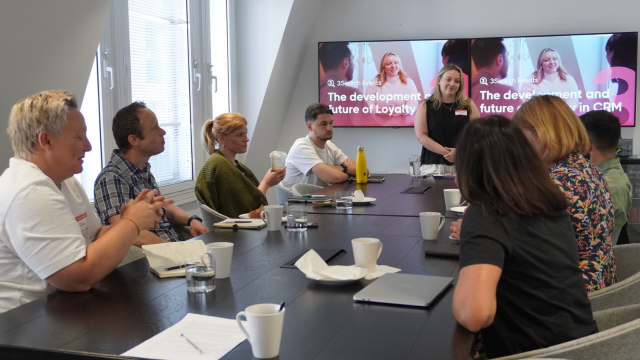Upload Your CV
Send us your CV and a member of the team will be in touch to discuss open opportunities with you.
Every business is trying to implement a loyalty scheme, but only a handful are doing it well...

Every business is trying to implement a loyalty scheme, but only a handful are doing it well. We recently held a roundtable discussion for leaders in the space to come together and discuss the challenges, trends and changes in loyalty strategies. Keep reading for the key takeaways from their conversation.
Over the last 12 months, we have seen an interesting shift in how loyalty roles are viewed by companies. With an influx of CRM contract jobs requiring loyalty experience, we have seen these positions become primarily interim, project-based positions.
To understand the momentum behind this change, specialist loyalty and CRM recruiter, Taylor Nash, held a roundtable discussion on the state of the market. Joined by leaders in the sector, they discussed:
Keep reading for the key takeaways.
Loyalty marketing is a strategy designed to attract, engage and retain customers by offering rewards tailored to the individual customer’s expectations. Historically managed by the Customer Relationship Management (CRM) team, we have seen a growth in ‘Loyalty’ job titles as more brands invest in the concept.
The Marketing Leaders in the room highlighted some examples of good 2025 loyalty schemes, including:
Customer experience can make or break a good loyalty scheme. The most effective programs are seamlessly integrated into the customer experience, offer clear and tangible value, and reflect a genuine understanding of what matters to the customer.
“You’re loyal to a brand, not a program.”
As the marketers in the room reminded us, consumers are loyal to a business – not a scheme. It's important that your brand is delivering value, so your customer interactions do not always feel like they’re being sold to.
Loyalty teams are under pressure to deliver. In the current economy, companies must balance the tension between driving the long-term value of loyalty and securing short-term wins.
According to our event attendees, there is a tendency to de-prioritise loyalty in favour of acquisition. One speaker shared how their business invested heavily in acquisition but almost nothing in retention. An incredible missed opportunity, as they could not create sustainable revenue streams from acquired consumers.
In many cases, loyalty propositions are often shut down as they do not generate instant results. Loyalty is not a quick win. It requires long-term investment in customer relationships, brand equity, and lifetime value. Brands that recognise this and commit to it strategically, are the ones best positioned to thrive.
Where business leaders do not understand the potential of loyalty programs, we’re seeing an impact on how roles and teams are shaped.
Loyalty roles are increasingly becoming contract or interim positions – brought in to deliver specific projects. This is not a sustainable approach. Our roundtable attendees agreed that this is a short-sighted approach, driven by a misunderstanding of what loyalty can deliver. It's important that Loyalty is seen as a key part of long-term growth, rather than just an addition to CRM responsibilities.
Contractors and Interim talent should be deployed to provide additional support for projects. They are not a replacement for permanent hires who would drive successful customer loyalty programs.
There is a clear disconnect between Loyalty Marketers and Business Leaders when it comes to the value of loyalty. To ensure you sustain funding and investment in your proposition, it’s important to communicate the value your programs deliver.
Too often, brands implement loyalty schemes without first defining what they’re trying to achieve. It could be:
Anecdotally, many roundtable attendees shared that they have joined a business to create a loyalty program without any other objective than they “thought they needed one.” Without that clarity, teams are left trying to justify their work retrospectively, making it harder to secure ongoing investment or stakeholder support.
In contrast, when programs start with a clear problem statement (such as addressing seasonal drop-off) teams are better positioned to design, test and scale initiatives that deliver measurable impact.
Another complication for loyalty marketing is ownership. The proposition is often split across CRM, marketing, product and commercial teams, with no clear owner. This fragmentation makes it difficult to embed loyalty into the broader business strategy.
Having a dedicated Loyalty Manager will allow you to bring each team together under one goal.
Looking ahead, the conversation turned to the future of loyalty - identifying where the opportunities lie to improve relationships with customers.
The event attendees highlighted a key opportunity to connect experiences across different channels. Brands should be creating loyalty propositions that feel relevant no matter where or how the customer interacts with a brand. Whether shopping in-store, online, via subscription, or through third-party platforms, customers expect brands to recognise them and reward them consistently.
A key difficulty for brands is ensuring their customers can earn rewards on orders through third-party platforms and mobile apps. With new technology integrations, Loyalty Marketers are hoping this should change in the future.
Another emerging priority is making better use of first-party data. As privacy rules tighten and third-party cookies phase out, brands are recognising just how valuable their own customer data is.
However, customers now expect something meaningful in return. Raconteur shared how attitudes towards data has evolved, with consumers viewing their data as a product to be sold. As a result, it’s incredibly important to ensure loyalty schemes are delivering value. They are the foundation for smarter, more personalised marketing and brand engagement.
A big thank you to our event attendees for sharing your thoughts, experiences and challenges with us. It was a truly insightful morning.
The loyalty marketing space is clearly continuing to evolve. Is your team set up for success? Get in touch with our specialist recruitment consultants to see how permanent and contract hires can help your business grow.